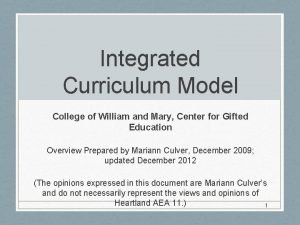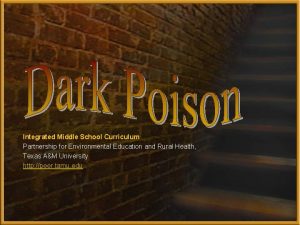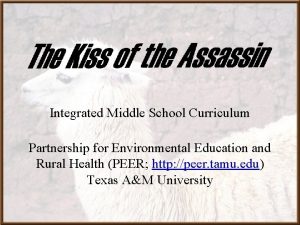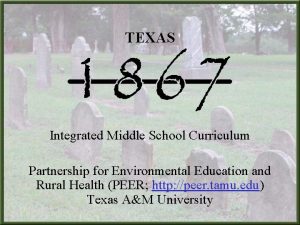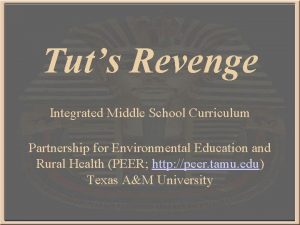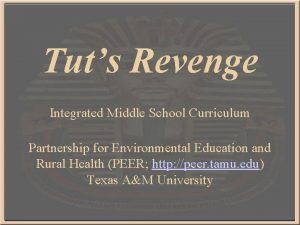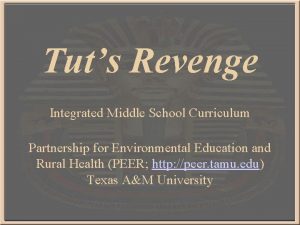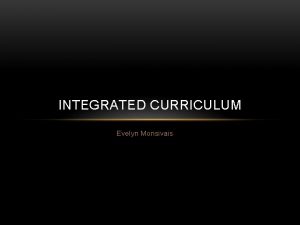Integrated Middle School Curriculum Partnership for Environmental Education















































































- Slides: 79

Integrated Middle School Curriculum Partnership for Environmental Education and Rural Health (PEER; http: //peer. tamu. edu) Texas A&M University

Primary Authors: Jon Hunter Bill Klemm Deborah Kochevar Jim Kracht Based on a story by Marguerite Swilling Production of the Partnership for Environmental Education and Rural Health funded by NIEHS, Larry Johnson, PI

Mr. or Ms. Smith’s class Your Middle School

Investigator’s Challenge Quiz Review the story, The Waterfall Ghost. Test your knowledge of the story by taking the Investigator’s Challenge Quiz. After you complete the quiz, return to the story and identify where to find each correct answer. WG-1. 0

Before the Industrial Revolution Because many technological changes took place in the 1700 s and 1800 s, this period is known as the Industrial Revolution. Before these changes took place, most work was done by hand, on everything from cloth weaving to farming. Most of the methods and tools used had been invented centuries before, often as far back as the Middle Ages. WG-2. 0

Before the Industrial Revolution Most tools were made either by a craftsperson, such as a blacksmith, or by the person who intended to use the tool. Traditional techniques of farming, house-building, cooking, and hunting were only changed when it was necessary in order to adjust to a new land. WG-3. 0

The Industrial Revolution Begins The new ideas of the Industrial Revolution began in Great Britain with advances in textiles, coal mining, iron making, and other industries. For many decades, Britain’s economy was the most advanced in the world, and they made a great deal of money in trade. WG-4. 0

The Industrial Revolution Begins When other countries wanted to adopt the new techniques, or industrialize, they often imported British ways of making machines. Many countries would pay people who were trained in the use of the new machines to move to their country and set up factories there. WG-5. 0

The Industrial Revolution Begins The English government passed laws to keep British inventions from being exported to other countries. Unfortunately, some people found ways around the laws and smuggled experts or blueprints out of the country anyway. In this way, the United States got started on its own Industrial Revolution. At the same time, American inventors came up with ideas of their own. Eventually, the United States became the most industrialized nation in the world. WG-6. 0

The Franklin Stove In the 1740 s, Benjamin Franklin invented the Franklin Stoves provided heat, light, and cooked food, yet earlier stoves were not very effective at heating a room. Franklin’s stove helped to keep the stove’s heat in the room, which he hoped would be a health benefit during cold New England winters. WG-7. 0

The Flour Mill Grain was ground into flour by mills in a very complicated process that required a lot of hard work on the part of the miller. In 1782, Oliver Evans created the “automatic” flour mill. His mill ran on water power from a nearby machine. Every step of the process was automated , including elevators that moved the grain from machine to machine so that the miller only had to put the grain sacks in, and cover the barrels of finished flour. WG-8. 0

The Cotton Gin Cotton was not, at this time, a very popular fabric because it was difficult to remove the fibers from the seeds. Picture of cotton field Source: Encarta Encyclopedia WG-9. 0 In the Middle East and India, cotton gins were used to separate the fibers, and by the 1740 s planters in Haiti were also using gins.

The Cotton Gin American cotton, unfortunately, had shorter fibers and so could not be processed using the gins of India or Haiti In 1793, Eli Whitney invented the first American cotton gin, and cotton soon became very widely used. WG-10. 0 Source: Smithsonian Institute

Hand Cards Hand cards were used to prepare clean fibers from cotton or wool to be made into yarn. Two pieces of leather, with nails sticking out like bristles on a hairbrush, were rubbed together with the fibers in between to line them up and make them easier to spin into yarn. In 1797, American inventor Amos Whittemore invented a machine that made the cards. The machine made the cards cheaply and easily. WG-11. 0 Source: http: //www. morguefile. com/archive/? display=102466&

Textile Machines Once the cotton gin was able to process American-grown cotton, businessmen in New England became interested in machines that could turn the fibers into finished cloth. Source: www. columbia. edu WG-12. 0 For information on early textile mills in America visit our supplement on the mills of Lowell, Massachusetts.

Iron-making The first ironworks in North America were built at Falling Creek, Virginia in 1619. By 1759, American iron was considered excellent for shipbuilding, a trade very important to the New England colonies. In England, iron was mined from tunnels underground, but in the colonies, it could be dug from open pits. Iron could also be scraped from the bottom of swamps. In this form, it was called “bog ore. ” WG-13. 0 This spring contains iron-bearing ground water, providing the iron for bog iron deposits.

Iron-making Over the next forty years, huge improvements came to the iron industry. Huge blast furnaces could create enough heat to melt the iron, which had not been possible before. The advances made in England between 1750 and 1800 were not widely used in the American iron industry until the 1840 s. WG-14. 0

Railroads George and Robert Stephenson were the father and son who ushered in the railway age. Source: A History of the Growth of the Steam Engine WG-15. 0 On September 27, 1825, the first train line opened in England, using a steam locomotive, the Locomotion, which the Stephensons had invented.

Railroads In 1830, the United States already had 23 miles of rails. This number grew to 2, 818 within ten years. By 1861, there were 166, 703 miles of railroad. Source: The United States Library of Congress WG-16. 0

Railroads In England, rail lines were built to be completely level, winding around hills instead of going up and down them. They worried that a train’s smooth wheels would not have traction on the smooth rails. William Norris of Philadelphia disproved this, and his locomotives sold well because of their ability to climb hills. WG-17. 0

Railroads An early innovation to the American train was the cow -catcher. Railways were not fenced, so cows sometimes wandered onto the lines. The cow-catcher scooped up the cow and threw it to one side, preventing a derailment. WG-17. 0

The Steamboat American inventor Robert Fulton was the first to successfully propel a boat with a steam engine. An early steamboat was once described as “an engine on a raft. ” Source: Old Steamboat Days on the Hudson River Robert Fulton’s Clermont WG-18. 0 Years later, steamboats reached their well-known form with a large paddlewheel on the aft (back) of the boat.

Interchangeable Parts The U. S. military wanted to be able to use weapons made of interchangeable parts, as these guns could be repaired on the battlefield more easily. In 1811, John Hall installed machines he had made to create these weapons at the federal arsenal in Virginia. WG-19. 0 Source: Harper’s Ferry National Historic Park. The federal arsenal at Harper’s Ferry, Virginia as it appeared in 1824.

Interchangeable Parts Hall’s system was tested when ten of his muskets, made between 1844 and 1853 were taken apart and their parts were mixed together. Workers reassembled the guns at random, and every single one fit and fired perfectly. These guns were very expensive, however, and were a luxury not all soldiers could afford. WG-20. 0

Thinking About the Industrial Revolution Look around your classroom: – How many things do you see that could have been made before the Industrial Revolution? – How many things do you see that could have been made during the Industrial Revolution? – Think about the things that were invented after the Industrial Revolution. How do you think the Industrial Revolution affected the creators of these new products? WG-21. 0

Investigate the Mystery What were the health problems you read about in the story? Who had the sickness? How might the sickness be spread? Source: Lowell National Historical Park WG-22. 0 What could be causing the sickness?

Let’s Make A Plan! What do you need to know to crack the case? What do you know and what do we need to find out about the sickness? Can you make a hypothesis? If so, what is your hypothesis? WG-23. 0

Coughing is a Symptom We cough in response to irritants that excite cough receptors in the lungs and airways. Irritants can include allergens, dust, and infections that cause irritation. Sometimes, excess mucus is produced to trap the irritants in the lungs or airways The body coughs to try to expel the mucus. Does this give you any ideas as to the cause of the sickness? WG-24. 0

What is a cough? How does it help? The cough reflex occurs when nerve fibers in the pharynx and bronchi are stretched or irritated. A nerve signal is sent to the brain via the vagus or laryngeal nerves. The brain then sends a signal to the diaphragm, laryngeal, intercostal, tracheal, bronchial, and abdominal muscles telling them to contract forcefully. Coughing occurs as part of an automatic reflex. Click here for more on reflex action. WG-25. 0 Source: Medline. Plus Intercostal muscles lie between the ribs and contract to pull the rib cage upwards, while the diaphragm contraction pulls downwards.

How a Cough Occurs The first phase, the inspiratory phase, occurs when a person takes a deep breath. In the next phase, the compression phase, the glottis closes and the bronchi narrow. Source: Medline. Plus Source: speech. llnl. gov The glottis, or vocal fold, can contract and cut off air flow in and out of the lungs. WG-26. 0 In the final phase, the expulsion phase, the glottis opens and the chest muscles contract forcefully to push air and any mucus out of the lungs.

What is phlegm? Phlegm is a thick mucus secreted in the respiratory passages in response to an irritant. Goblet cells found in the airways of the respiratory tract secrete the phlegm. The phlegm traps the irritants. Ciliated epithelial cells move the phlegm up and out of the respiratory system. What would happen if phlegm stayed in the lungs? WG-27. 0 Some people call it the “creeping crud!”

What is making the people in the story cough? Does the coughing sound like anything you have ever had or seen before? What is suggested by the comments in the story that some workers get better on their day off? WG-28. 0

Which disease fits the bill? Disease Symptoms Disease Cough Lung Cancer Bloody Sputum Short of Breath Cough Obstructive Lung Disease Cough Cold Sore Throat Sneezing Cough Tuberculosis Fatigue Weight Loss Symptoms Wheezing Short of Breath Cough-phlegm Pneumonia Pneumonic Plague Fever Fatigue Severe cough Bloody sputum Short of Breath Click on a disease to help you figure it out!! WG-29. 0

Comparison of Symptoms Chronic Bronchitis Chronic Asthma • Phlegm -containing cough • Cough • Shortness of breath • Wheezing • Fatigue • Swelling in lower limbs WG-30. 0 • Shortness of breath • Tightness in chest Emphysema • Phlegm- or non-phlegm -containing cough • Shortness of breath • Wheezing • Fatigue • Swelling in lower limbs (occasional) What do all of these conditions have in common?

Chronic Bronchitis The bronchi inflame and produce large amounts of mucus. The mucus cannot be expelled since the cilia in the airways are paralyzed. Source: Medline. Plus WG-31. 0 The excess mucus allows bacterial diseases, such as pneumonia, to occur.

Chronic Asthma The smaller airways in lungs constrict due to spasms in the smooth muscle in the walls of the airways. Smooth muscle spasms are the body’s reaction to allergens, like dust or smoke. Sometimes the airways become so clogged that airflow is completely cut off, leading to death. WG-32. 0 Source: Medline. Plus Many people use inhalers during an asthma attack to dilate the airways so that they can breathe.

Emphysema is a permanent condition in which the alveoli breakdown and smaller airways collapse, leading to a decrease in lung elasticity and inneficient CO 2 and O 2 exchange. Scarring can occur when the alveoli break down. Source: Medline. Plus Visit the PEER website for more information on oxygen exchange and emphysema! WG-33. 0 A person with emphysema does not experience any symptoms until 50 -70% of their lung capacity has already been lost.

Investigating Water Summer noticed that the waterfall was brown. This waterfall supplied the whole town with their water supply. Could something in the water be causing the sickness? Source: Lowell National Historical Park WG-34. 0

Investigating Air Industry and railroads produce a lot of pollution. Pollution cause all sorts of respiratory problems. Could the pollution in the air be the problem? WG-35. 0

Investigating the Mill Is there something in the mill that could be causing the sickness? What are some of the things that Summer noticed during their midnight escapade in the mill? Source: Lowell National Historical Park WG-36. 0

Could it be iron poisoning? Summer said the machines were made out of iron. Is it possible that the iron from the machines could infect the mill workers and cause the disease? Source: Lowell National Historical Park WG-37. 0

Could it be Mr. Farnsley? Not only did Mr. Farnsley smoke, but he also used locofoco to light his pipe. Could the smoke and/or the locofoco cause the sickness seen in the story? What are the health effects of smoking? WG-38. 0

Could it be the dust? Summer noticed a white chalky dust that clung to the back of her throat. Could the dust be causing the illness? What is the source of the dust? Are there diseases caused by dust inhalation? WG-39. 0

Was your hypothesis correct? What was your original hypothesis? After investigating possible causes, do you still like your original hypothesis? If not, what is your new hypothesis? To learn more about the disease, click here. WG-40. 0

What Is Cotton? Cotton is a soft fiber of pure cellulose that grows around seeds of the cotton plant. Cellulose consists of a long sequence of glucose molecules. The –OH groups on the molecules attract water and are the reason why cotton is so absorbent. (See picture at top left) Source: msa. ars. usda. gov Electron micrographs of a single cotton fiber. WG-41. 0 Each cell in the boll becomes a hollow, tubular fiber. When the bolls open, the fibers dry out and coil. The dead fibers coil together tightly, giving cotton its classic strength and durability.

Why doesn’t cotton rot? Cotton doesn’t rot because it is made out of a single, hollow fiber that does not contain any organelles or cytoplasm. When cotton cells die, they just dry up. They do not react with the atmosphere and rot because there are no enzymes to destroy the cotton. Have you ever noticed that when a stalk of celery rots, the fibers in the stalk are still intact? WG-42. 0 Cotton plants actually can rot! Farmers spray the plants to dry them out before they can spoil and ruin the cotton fiber.

The History of Cotton The word cotton originated from the Arabic word qutun. Cotton fibers have been found that are about 7, 000 years old. The fiber was first spun by a machine in England in 1730. Samuel Slater brought English textile manufacturing to America in the 1790 s. This was the beginning of the American Industrial Revolution. WG-43. 0 Some researchers believe that cotton may have first been used by Egyptians over 12, 000 years ago!!

Eli Whitney saw the need for a machine to pick apart the sticky seeds from the fiber while working at a Georgia plantation. He invented the first cotton gin in 1793. His design was easily copied and Whitney ended up spending most of his time suing for copyright infringement instead of making money. WG-44. 0

The Economics of Cotton After the invention of the cotton gin, the value of U. S. cotton rose from $150, 000 to $8 million. The gin reduced the need for slaves to pick the seeds out of the cotton, but it increased the need for slaves to grow and pick the cotton. Visit Cotton Counts to learn even more about cotton! After 1800, the slave trade boomed and by 1860, slaves accounted for 1/3 of the population of the South. The price of land slaves kept large cities and industry from forming in the South. WG-45. 0

Other Fabric Sources: Hemp is a very strong, stringy fiber that comes from the Cannabis plant. Unlike cotton, the hemp fiber comes from the stalk of the dried plant. Hemp isn’t very soft like cotton or wool, but it is much stronger. Hemp is easily grown and grows in very thick clusters. Hemp can be used for clothing, rope, paper, and many other things. WG-46. 0

What is Flax? Flax is a fibrous plant that is cultivated for its seed and fiber. The seed is used to make linseed oil and the fiber is used to make paints, stains, particleboard, and linoleum. Flax is mostly grown in the northern half of the United States and in Canada. Source: nal. usda. gov WG-47. 0

What is Sisal? Sisal is an agave plant that produces fibers in its vascular tissue. These short, stout fibers are used in the automotive industry in brakes and clutches. It is also used to enhance texture in paint. This fiber is also called sisal hemp. WG-48. 0 Source: www. capitolmuseum. ca. gov Click here for more on the Century plant.

Tuberculosis Puzzler In 1907, there were 4, 000 reported cases of tuberculosis in Boston. Of the 1, 100 women who lived at the Channing Home in Boston, 4/5 of these women had tuberculosis. What percentage of the cases in Boston were found in the Channing Home? WG-49. 0

The Passage of Time In the book Summer read, she learned that Bobbin drowned on September 13, 1853. If Summer was 14 years old on November 4, 2004, and her birthday was on August 2, how many full years passed from the time Bobbin drowned to the time Summer was born? WG-50. 0

How many books? While her mother talked to Mr. Witherspoon, Summer decided to calculate the number of books in the bookstore. Each wall (4 walls total) was lined with one enormous bookcase. Each bookcase had 10 shelves; each shelf held 25 books. In the middle of the store were 15 bookcases, each with 7 shelves holding 15 books each. How many books were in Mr. Witherspoon’s bookstore? WG-51. 0

A Long Walk An average person walks at the speed of about 1 meter per second. If Lowell, Massachusetts is 41. 5 kilometers from Boston, how many hours would it take the person to walk from Lowell to Boston? WG-52. 0

What’s the distance? It took Bobbin and Summer 15 minutes to travel from the park to the mill where Bobbin had worked. If they were traveling at 1 meter per second, how far is the park from the mill in kilometers? WG-53. 0

A Dusty Dilemma The air in the mill where Bobbin had worked was filled with chalky dust. Assume that the mill is a rectangular prism, with a length of 40 meters, a width of 25 meters, and a height of 50 meters. If there were 2500 particles of dust per cubic meter, how many dust particles were in this air? WG-54. 0

How much water falls? Summer recorded the amount of water going over the Pawtucket Falls per minute. She discovered that there were 250 liters per minute going over the falls. How much water went over the falls in 1 hour and 20 minutes? WG-55. 0

Count the Coughs Bobbin coughed an average of 4 times every 45 minutes. If Summer talked to Bobbin for 2 hours and 15 minutes, how many times did Bobbin cough during this time? WG-56. 0

Cough It Up Every time Mary-O coughed, she coughed up 0. 15 g of phlegm. If she coughed 6 times, and 1 ounce = 28. 35 grams, how many ounces of phlegm did Mary-O cough up? WG-57. 0

Estimate the Bacteria Pneumonia can be caused by bacteria. Assume that there are 150 bacteria per gram of phlegm. If a person with pneumonia coughed up 0. 5 grams of phlegm every 5 minutes, how many bacteria are in the total amount of phlegm coughed up after 45 minutes? WG-58. 0

A Chronic Problem Approximately 12. 1 million people in the United States have chronic bronchitis. This is about 4. 45% of the population. There were 1, 172 deaths due to chronic bronchitis in 1999. What percent of the U. S. population is this? WG-59. 0

How much are your lungs worth? If a worker was paid $1. 25 an hour to work in the mill and received a 2. 5% raise every year, how much would the worker earn per hour after 5 years? WG-60. 0

Unlocking Language Build your language skills by carefully reading The Waterfall Ghost. Practice these skills by completing the Unlocking Language activities. WG-61. 0

Vocabulary Challenge Take the Vocabulary Challenge Quiz to test your skill at finding word meanings. WG-62. 0

Challenges Bobbin is only 13 years old in the story. She has faced many challenges in her young life. Make a list of at least three of the biggest challenges she has faced. WG-63. 0

Challenges Do you think Bobbin has dealt with her challenges successfully? Pick two challenges from your list and write an essay describing why you believe Bobbin has or has not dealt with these challenges effectively. WG-64. 0

Personal Challenges • What challenges have you faced in your life? • Did your challenges involve other people? • Did physical circumstances play a role? WG-65. 0

Personal Challenges Pick one challenge that you believe you have handled well. Then write an essay about it, with the following elements: – A description of the challenge – How you handled it – Advice for others who might face similar challenging circumstances WG-66. 0

Public Challenges One challenge that all animals, including people, face is staying healthy. What aspects of work in the textile factory made this especially hard for the mill girls? WG-67. 0

Public Challenges Imagine that you are the safety inspector for the textile factory in this story. Make a list of 3 things that you believe should be changed to make the working environment healthier for the factory workers. WG-68. 0

The Assignment Compose a letter to Mr. Lowell addressing one safety hazard from your list. Include the following in your letter: 1. A clear statement of the hazard. 2. Data that explains why this aspect of the workplace is dangerous. You will need to research your topic and find scientific reasons to support your claim. 3. Why it is good for Mr. Lowell’s business if he addresses this hazard. WG-69. 0

The Story’s Setting Read the description of Lowell, MA at right. From whose perspective are we seeing the town? Can perspective affect the way a description is written? WG-70. 0 Huge five-story buildings lined the farther bank, and upriver could be seen locks and canals that fed river traffic to the massive factories. Long rows of two-story buildings were interspersed with the factories and everywhere people bustled along the roadways and canal bridges, moving between the buildings and the railroad tracks that lined the streets.

The Story’s Setting Would the description you read change if the following people were writing it? • Travel agent who wanted visitors to come to Lowell for a vacation. • Businessperson who was trying to attract new factories to town. • Young child visiting a big city for the first time. WG-71. 0

Your World Imagine you are writing from one of the perspectives on the list, or from a new perspective of your choice. Select some aspect of your town to describe from this perspective in a one-page essay. WG-72. 0

Impressions Exchange essays with a classmate for editing, but do not tell the classmate from which perspective you were writing. Can your classmate determine the perspective you chose by reading your essay? WG-73. 0

Teachers, please click on this link to complete a short survey concerning this module: http: //peer. tamu. edu/forms/Curricula_Survey. shtml. This product is available through the cooperation of the following: National Institute of Environmental Health Sciences Department of Agricultural Education, Texas A&M University Partnership for Environmental Education and Rural Health The Center for Environmental and Rural Health College of Education, Texas A&M University College of Veterinary Medicine, Texas A&M University

List of Slide Numbers that Correspond to the Different Subject Areas Science Slides WG 22. 0 -42. 0 Social Studies Slides WG 2. 0 -21. 0, 43. 0 -48. 0 English Slides WG 1. 0, 61. 0 -73. 0 Math Slides WG 49. 0 -60. 0
 Wireless health
Wireless health Integrated curriculum model
Integrated curriculum model Integrated vs differentiated curriculum
Integrated vs differentiated curriculum Nursing education partnership initiative
Nursing education partnership initiative Scope of public-private partnership in education
Scope of public-private partnership in education Inclusive education and community partnership
Inclusive education and community partnership Miguel lopez melero
Miguel lopez melero Dermalogica european massage steps
Dermalogica european massage steps Heathfield junior school partnership
Heathfield junior school partnership Contoh ihes
Contoh ihes Integrated educational information management system
Integrated educational information management system Iqms tutorial
Iqms tutorial Fspos
Fspos Novell typiska drag
Novell typiska drag Nationell inriktning för artificiell intelligens
Nationell inriktning för artificiell intelligens Returpilarna
Returpilarna Varför kallas perioden 1918-1939 för mellankrigstiden?
Varför kallas perioden 1918-1939 för mellankrigstiden? En lathund för arbete med kontinuitetshantering
En lathund för arbete med kontinuitetshantering Särskild löneskatt för pensionskostnader
Särskild löneskatt för pensionskostnader Tidbok för yrkesförare
Tidbok för yrkesförare A gastrica
A gastrica Vad är densitet
Vad är densitet Datorkunskap för nybörjare
Datorkunskap för nybörjare Tack för att ni lyssnade bild
Tack för att ni lyssnade bild Debatt mall
Debatt mall Delegerande ledarstil
Delegerande ledarstil Nyckelkompetenser för livslångt lärande
Nyckelkompetenser för livslångt lärande Påbyggnader för flakfordon
Påbyggnader för flakfordon Tryck formel
Tryck formel Publik sektor
Publik sektor Kyssande vind
Kyssande vind Presentera för publik crossboss
Presentera för publik crossboss Jiddisch
Jiddisch Kanaans land
Kanaans land Treserva lathund
Treserva lathund Epiteltyper
Epiteltyper Claes martinsson
Claes martinsson Centrum för kunskap och säkerhet
Centrum för kunskap och säkerhet Verifikationsplan
Verifikationsplan Mat för unga idrottare
Mat för unga idrottare Verktyg för automatisering av utbetalningar
Verktyg för automatisering av utbetalningar Rutin för avvikelsehantering
Rutin för avvikelsehantering Smärtskolan kunskap för livet
Smärtskolan kunskap för livet Ministerstyre för och nackdelar
Ministerstyre för och nackdelar Tack för att ni har lyssnat
Tack för att ni har lyssnat Vad är referatmarkeringar
Vad är referatmarkeringar Redogör för vad psykologi är
Redogör för vad psykologi är Matematisk modellering eksempel
Matematisk modellering eksempel Atmosfr
Atmosfr Borra hål för knoppar
Borra hål för knoppar Orubbliga rättigheter
Orubbliga rättigheter Formel standardavvikelse
Formel standardavvikelse Tack för att ni har lyssnat
Tack för att ni har lyssnat Steg för steg rita
Steg för steg rita Ledningssystem för verksamhetsinformation
Ledningssystem för verksamhetsinformation Tobinskatten för och nackdelar
Tobinskatten för och nackdelar Toppslätskivling effekt
Toppslätskivling effekt Datumr
Datumr Egg för emanuel
Egg för emanuel Elektronik för barn
Elektronik för barn Mantel för kvinnor i antikens rom
Mantel för kvinnor i antikens rom Strategi för svensk viltförvaltning
Strategi för svensk viltförvaltning Kung som dog 1611
Kung som dog 1611 Indikation för kejsarsnitt på moderns önskan
Indikation för kejsarsnitt på moderns önskan Romarriket tidslinje
Romarriket tidslinje Tack för att ni lyssnade
Tack för att ni lyssnade Multiplikation med uppställning
Multiplikation med uppställning Cirkelkomposition dikt
Cirkelkomposition dikt Inköpsprocessen steg för steg
Inköpsprocessen steg för steg Rbk mätning
Rbk mätning Etik och ledarskap etisk kod för chefer
Etik och ledarskap etisk kod för chefer Expektans
Expektans Myndigheten för delaktighet
Myndigheten för delaktighet Trög för kemist
Trög för kemist Tillitsbaserad ledning
Tillitsbaserad ledning Läkarutlåtande för livränta
Läkarutlåtande för livränta Stig karttecken
Stig karttecken Lek med geometriska former
Lek med geometriska former Shivaiter
Shivaiter Meios steg för steg
Meios steg för steg

